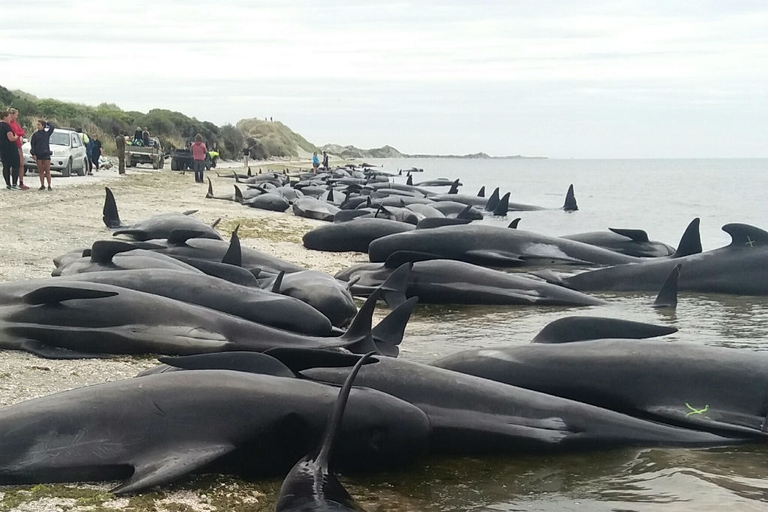
Our species took its first steps in a world covered in trees. Today, forests offer us sustenance, shelter, and clean the air that we breathe.
The news of a mass whale stranding (at least 400 pilot whales) at Farewell Spit, New Zealand, had the world talking about its extent. Over the past week, hundreds of volunteers and NGOs tried to bring as much pilot whales as possible back to sea, but at least 300 of them were already dead when
The news of a mass whale stranding (at least 400 pilot whales) at Farewell Spit, New Zealand, had the world talking about its extent. Over the past week, hundreds of volunteers and NGOs tried to bring as much pilot whales as possible back to sea, but at least 300 of them were already dead when found.
Despite the effort of experts and volunteers, 70 per cent of them died during the night of 10 February. The living individuals were refloated, but most of them beached themselves again during low tide.
BBC reported that on 12 February 200 more pilot whales stranded themselves. Experts still don’t know the reason why whales came ashore. Andrew Lamason of Takaka’s conservation department suggests that Golden Bay is “almost a perfect trap for pilot whales for its geography”. According to authorities, it’s the third largest whale stranding in New Zealand’s history. In 1918, 1,000 whales beached themselves on the Chatham Islands, and in 1985 450 stranded at Great Barrier Island off the coast of Auckland.
UPDATE: 20 Pilot Whales have been euthanized; the 80 surviving whales were refloated & have joined the second group of 200 & remain offshore pic.twitter.com/Qvjebo24N4
— Quad Finn (@Quad_Finn) February 11, 2017
Many factors can lead whales to strand themselves. Among them are the complex social bonds pilot whales build in their pods, which lead individuals to go after old, sick individuals and thus beach themselves in shallows. Researchers claim, however, that this usually happens in small pods.
Others suggest that whale strandings are linked to human activities, especially seismic prospecting. This testing surveys the diffusion of seismic waves generated in an artificial way, including airguns – blasts used to find oil and gas deep underneath the ocean floor.
According to a study publish in the journal Nature, heavy noise pollution can have harmful effects on marine animals, particularly on those who based their own communication and geolocation systems on sound waves. “There is an urgent need to develop methods for assessing the effects of underwater man-made noise on cetaceans,” reads the introduction of the study (Implementation of a method to visualize noise-induced hearing loss in mass stranded cetaceans). “High intensity active sonar, and other loud noise sources, for example those from gas exploration, seismic surveys, etc., have the potential to cause lesions to exposed animals. Depending on the distance from the source, injuries can be lethal”.
What’s clear, not only among conservationists, is that there’s the need of properly regulating and programming human activities that can be harmful to marine wildlife.
Siamo anche su WhatsApp. Segui il canale ufficiale LifeGate per restare aggiornata, aggiornato sulle ultime notizie e sulle nostre attività.
![]()
Quest'opera è distribuita con Licenza Creative Commons Attribuzione - Non commerciale - Non opere derivate 4.0 Internazionale.
Our species took its first steps in a world covered in trees. Today, forests offer us sustenance, shelter, and clean the air that we breathe.
Poachers in Africa are encroaching on wildlife land and killing rhinos in travel hot spots now devoid of visitors due to the coronavirus pandemic.
Actor and environmental activist Leonardo DiCaprio has contributed two million dollars to a fund to protect Virunga National Park in Congo from threats such as terrorism, the coronavirus and poaching.
For the first time in seventeen years, Iceland’s two main whaling companies won’t resume whale hunting. The announcement concerns this year’s season but could carry into the future.
The relationship between the coronavirus and wildlife is complex: while the pandemic may lead to a reduction in the illegal trade in wild animals, it may also encourage it in other respects.
The largest coral reef in the world is severely threatened by climate change, but researchers are developing strategies that could contribute to saving the Great Barrier Reef.
NGO Free the Bears has opened a mountain sanctuary for moon bears in Laos. With the government’s help, it aims to close all bile farms by 2022.
Seychelles have extended its marine protected area, which now covers over 400,000 square kilometres, an area larger than Germany.
The tapir was reintroduced into Brazil’s Atlantic Forest, the country’s most at-risk ecosystem. The species can play a key role in the forest’s recovery.








